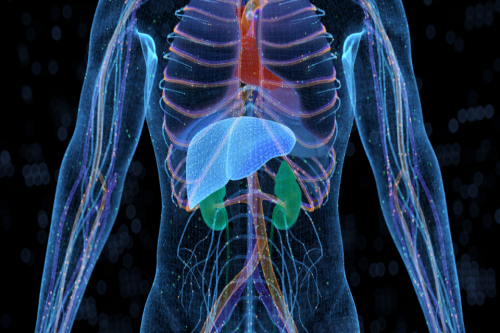Fatty Liver and Kidney Disease Primer

What is Fatty Liver?
While you may have heard that too much alcohol can lead to liver problems, you might be less familiar with another leading cause of liver disease that affects an estimated 24% of adults in the United States—nonalcoholic fatty liver disease (NAFLD). The National Institute of Diabetes and Digestive and Kidney Diseases (NIDDK) describes NAFLD as a buildup of extra fat in the liver that is not caused by heavy alcohol use. In the majority of patients with nonalcoholic fatty liver (NAFL) this does not cause damage to the liver (1). A smaller group of patients with NAFLD develop nonalcoholic steatohepatitis (NASH) which is accompanied by inflammation and can lead to cirrhosis or liver cancer (1).
How does this affect people with kidney disease?
While the causes of NAFLD are not well understood, certain health conditions might increase the risk of NAFLD. These health conditions include obesity, type 2 diabetes, and high blood triglycerides or cholesterol levels (1). Scientists are still studying how NAFLD affects other health conditions, but research suggests that there may be a connection to development of chronic kidney disease (CKD) (2-3). Additionally, risk of heart disease is known to be increased for patients with CKD and also appears higher among patients with NAFLD (3).
Are there diet changes that can help?
In addition to physical activity and gradual weight loss for those who are overweight or obese, a healthy diet is recommended to prevent or manage NAFLD (1). People with kidney disease can generally apply the same diet changes that are recommended for NAFLD patients.
Watch portion sizes. This strategy is important to prevent weight gain or if you are trying to gradually reduce weight by controlling calorie intake. Portion sizes are also an important tool in managing blood sugar levels for people with diabetes.
Cut back on sugary foods and drinks. A potential link between fructose and fatty liver is an active area of research (1-2). Common sources of fructose include sweetened drinks and table sugar which breaks down to glucose and fructose. Limiting sugary foods helps manage blood glucose levels as well.
Choose healthy fats. Both CKD patients and those with NAFLD may be more at-risk for heart disease, making a heart healthy diet important. Heart healthy diets limit saturated and trans fats and instead include more sources of mono- and polyunsaturated fats by including plant-based oils, fatty fish and lean meats. Check out these resources on implementing a heart healthy diet that is also kidney friendly:
- 6 Ways to Support Your Heart Health
- Food Facts Friday: Cooking Oils
- 7 Heart Healthy Mediterranean Dishes
References
- National Institute of Diabetes and Digestive and Kidney Diseases (NIDDK). Nonalcoholic Fatty Liver Disease (NAFLD) and NASH. Available at https://www.niddk.nih.gov/health-information/liver-disease/nafld-nash
- Marcucilli M and Chonchol M. NAFL and Chronic Kidney Disease. Int J Mol Sci. 2016 Apr; 17(4): 562. Available at https://www.ncbi.nlm.nih.gov/pmc/articles/PMC4849018/
- Musso G et al. Association of Non-alcoholic Fatty Liver Disease with Chronic Kidney Disease: A Systematic Review and Meta-analysis PLoS Med. 2014 Jul; 11(7): e1001680. Available at https://www.ncbi.nlm.nih.gov/pmc/articles/PMC4106719/
Additional Kidney Diet Resources
Visit DaVita.com and explore these diet and nutrition resources:
- DaVita Food Analyzer
- DaVita Dining Out Guides
- Today’s Kidney Diet Cookbooks
- DaVita Kidney-Friendly Recipes
- Diet and Nutrition Articles
- Diet and Nutrition Videos
- Kidney Smart® Virtual Classes
This article is for informational purposes only and is not a substitute for medical advice or treatment. Consult your physician and dietitian regarding your specific diagnosis, treatment, diet and health questions.

Recent Comments